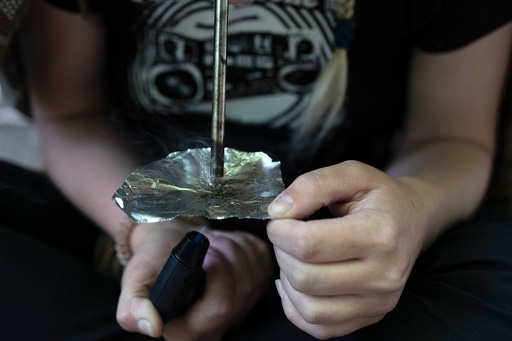Hard drugs illegal again in Oregon as first-in-nation experiment ends
By Ben Brasch
The Washington Post
September 1, 2024

A homeless woman smokes fentanyl, June 28, 2024, in Portland, Ore.
As of Sunday, it is, once again, illegal to possess small amounts of hard drugs in Oregon. A first-in-the-nation law decriminalizing drugs expired, as communities across America struggle to curb fentanyl use and overdose deaths.
Sunday marks the end of an experiment that drug-reform advocates called a pioneering and progressive measure to better help people. Oregon legislators reassessed Measure 110 this year and decided to again make it a misdemeanor to possess a minor amount of drugs — essentially anything besides marijuana. Selling and manufacturing illicit drugs was and is still illegal in Oregon.
Those who supported the measure said it sought to help instead of simply handcuff, by offering services as opposed to the stigma of an arrest, which can make it harder to find a job or a place to live. The most vocal advocate was the Drug Policy Alliance, which spent more than $4 million on the campaign.
The measure required officers to hand out $100 citations instead of jail time, and that citation could be waived if the person called a state-funded hotline and enrolled in an assessment for treatment. Those services were funded by hundreds of millions of dollars in marijuana tax revenue. (Marijuana has been legal in Oregon since 2015.)
The alliance and others used Portugal, which decriminalized certain hard drugs in 2001, as a model — despite Portugal mulling changes of its own to the law.
The Oregon campaign emphasized a study showing that Black and Native American people were more likely to be convicted of drug crimes than White people and must deal with the consequences for decades.
The vote came in November 2020 during a wave of calls for criminal justice restructuring that crested after the murder of George Floyd, an unarmed Black man, by a Minneapolis police officer.
The measure passed with support from about 60 percent of voters.
“We have been criminalizing people for at least 50 years, and what we know is that it hasn’t gotten us any closer to having our loved ones get the care that they need at the scale that it requires,” Kassandra Frederique, the alliance’s executive director, told The Washington Post at the time.
But the program’s problems were clear right away.
Because of decades of underinvestment in behavioral health services, there weren’t enough providers to care for drug users, experts said. The health-care system was stretched thin by the coronavirus pandemic. When the measure passed, state officials said Oregon ranked last in the nation for providing access to substance-use disorder treatment. Then state auditors raised concerns about the way the Oregon Health Authority managed grants meant for substance-abuse programs.
Then there was fentanyl. Up to 50 times stronger than heroin, fentanyl in 2021 was just hitting its peak on the West Coast after wreaking havoc elsewhere in the nation. This January, the soaring number of fentanyl overdoses prompted state and local leaders to declare a 90-day state of emergency in downtown Portland.
Supported by polling that showed that citizens no longer backed decriminalization, The Post reported, politicians and business leaders filed initiatives to let voters to “fix and improve” the law.
Soon after, Oregon legislators convened.
On Feb. 29, the Oregon House of Representatives voted 51-7 to recriminalize drugs, with bipartisan support. The Oregon Senate did the same by a vote of 21-8 the next day. Gov. Tina Kotek (D) signed recriminalization into law April 1.
Data shows how the law was used in practice. The Oregonian reported that circuit court data collected by the Oregon Judicial Department from when the law went into effect Feb. 1, 2021, to Aug. 26, 2024, showed that the state’s circuit courts imposed just under $900,000 in fines under the measure but collected only $78,000 of those fines.
The conviction rate for the 7,227 people cited was 89 percent, with most of those because people didn’t show up to court, the Oregonian reported. Data showed that 85 people completed the substance-abuse screening in lieu of a conviction.
The most commonly cited drug was methamphetamine, accounting for 54 percent of citations. Fentanyl and other Schedule II drugs, the Oregonian reported, ranked second, at 31 percent.
Advocates of the measure were saddened by what they viewed as a backward move from lawmakers.
“It’s easier for the legislature to blame and stigmatize and disappear people into jails than to fix the problem they had a hand in creating,” Emily Kaltenbach of the Drug Policy Alliance previously told The Post.
The last day the measure was in effect was Saturday, which was Overdose Awareness Day.
1 comment:
Sometimes things just don't work out.
Post a Comment